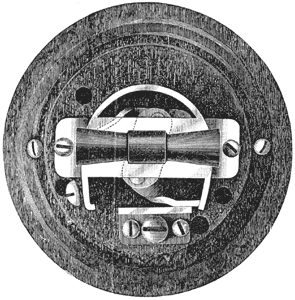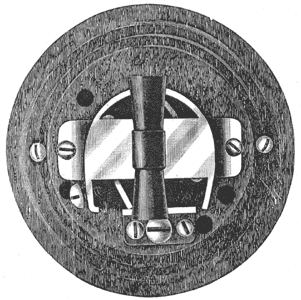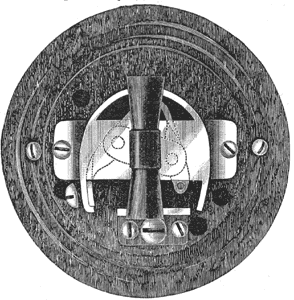[Trade Journal]
Publication: Electrical Review
New York, NY, United States
vol. 13, no. 25, p. 2-3, col. 2,1
Incandescent Switches.
We illustrate, on the opposite page, a novel switch for incandescent work, designed by Mr. H. T Paiste, of Philadelphia, Pa. Practical workers in incandescent wiring will appreciate the efforts of the designer in attempting to avoid the use of spring brass for electrical contact, experience having demonstrated that the contact, unless soldered, will, in time, through corrosion or dust, be heated, removing the temper from the brass, and thereby destroying electrical contact. As shown in the illustrations, the entire switch is stamped from sheet (not spring) brass by standard dies, making all parts interchangeable.
The parts of the switch, Fig. 1, consist of seven pieces, viz : the U-shaped main shell, side plate, two arms, spindle, spring, and hard rubber handle. The spring is attached to the ends of two arms and is extended when the switch is being operated to make or break circuit. As soon as this is accomplished, the spring is no longer under tension. The circuit wires are attached to binding screws on the U-shaped main shell and side plate. The arm, as shown in Fig. 1, completes the circuit, between the side plate and the main shell, at its point and through the spindle, upon which it is centered, making ample electrical contact. In breaking the circuit, the handle which is attached to the spindle turns to the right, moving the arm up the side plate, preserving sufficient electrical contact at its point until the position shown in Fig. 2 is reached ; then the spring which joins the ends of the arms, being lengthened as the arm climbs the side plate, throws the same rapidly to the position shown in Fig. 3, instantly breaking the circuit. Whatever arching might result would be on the back of the arm, and not on the face, where electrical contact is made. The making of the circuit is accomplished in like manner by the second arm.
An improved handle has been added to switch which obviates injury to it, for if turned backwards it will unscrew instead of straining the working parts.
Mr. Paiste has given this switch a thorough test of twelve months at the sea shore and at sulphur springs, where corrosion destroys many switches. The reports from these places have been most satisfactory, not a switch having been destroyed. The switch has been adopted by a number of central stations.
 |
| Fig. 1. — the Paiste Switch. |
 |
| Fig. 2. — the Paiste Switch. |
 |
| Fig. 3. — the Paiste Switch. |
